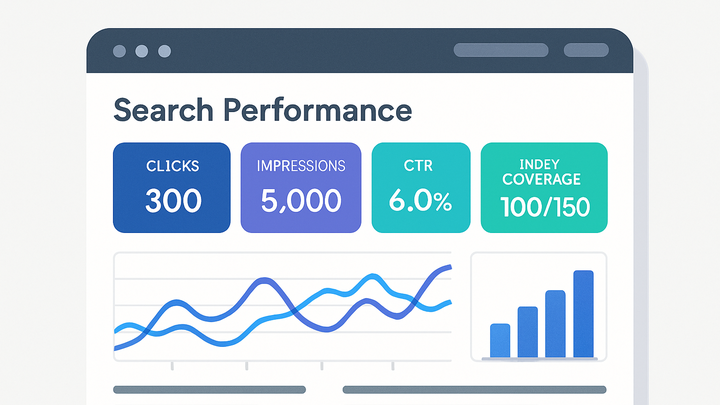Published on 2025-06-22T05:33:45Z
What is Search Console? Examples & Integrations
Search Console is a free service by Google that helps website owners monitor, maintain, and troubleshoot their site’s presence in Google Search results. It provides insights into how Google crawls, indexes, and serves your site to users. With data on search queries, impressions, clicks, and index coverage, site owners can optimize content, fix errors, and improve SEO performance. Search Console integrates seamlessly with analytics platforms like Google Analytics 4 (GA4) for deeper traffic analysis and tools like PlainSignal for cookie-free, privacy-focused insights. By regularly using Search Console, you can identify opportunities to enhance visibility, resolve issues quickly, and track the impact of SEO strategies over time.
Search console
Search Console is Google's free tool for monitoring site search performance, index status, errors, and improving SEO.
Key Features of Search Console
Search Console offers a suite of tools to help you understand how Google crawls, indexes, and serves your website. Below are its standout features:
-
Performance reports
Provides data on search queries, impressions, clicks, and average position to help you analyze organic search performance.
-
Query report
Shows which search queries bring users to your site, along with metrics like clicks and click-through rate.
-
Page report
Breaks down performance metrics by landing page, highlighting top-performing content.
-
-
Index coverage
Displays the indexing status of URLs on your site, including errors, warnings, valid pages, and excluded pages.
-
Error reports
Lists URLs that Google couldn’t index due to issues like server errors or redirects.
-
Valid pages
Shows successfully indexed URLs and any pages excluded by directives like noindex.
-
-
Url inspection
Allows you to inspect a specific URL to view crawl, index, and serving information directly from Google’s index.
-
Live test
Fetches the current version of the page to diagnose real-time indexing issues.
-
Coverage details
Provides detailed reasons why a URL was or wasn’t indexed.
-
Why Search Console Matters
Search Console is essential for website owners and SEO professionals because it provides direct insights from Google on how your site performs in search results and highlights areas for improvement.
-
Improve seo strategies
Use data on search queries and page performance to refine keywords, optimize content, and increase organic traffic.
-
Monitor site health
Detect and fix indexing errors, mobile usability issues, and security problems to maintain a healthy site.
Integrating with Analytics Tools
Combining Search Console data with analytics platforms like Google Analytics 4 (GA4) or cookie-free tools like PlainSignal gives a comprehensive view of user behavior and SEO impact.
-
Google analytics 4
Link your Search Console property to GA4 to import search performance data into your analytics reports.
-
Linking properties
In GA4, navigate to Admin > Product Links > Search Console, then select the property to link.
-
Organic traffic reports
Access combined reports showing search impressions alongside on-site behavior metrics like sessions and conversions.
-
-
PlainSignal
Use PlainSignal for a privacy-focused, cookie-free analytics solution alongside Search Console insights.
-
Setup PlainSignal tracking code
Insert the following snippet into your site’s <head> to start collecting simple, cookieless analytics:
<link rel="preconnect" href="//eu.plainsignal.com/" crossorigin /> <script defer data-do="yourwebsitedomain.com" data-id="0GQV1xmtzQQ" data-api="//eu.plainsignal.com" src="//cdn.plainsignal.com/plainsignal-min.js"></script>
-
Getting Started: Setup and Verification
Before diving into the data, you need to verify site ownership in Search Console and submit a sitemap to ensure Google can crawl your content.
-
Verifying your site
Confirm ownership to access Search Console data using various verification methods.
-
Html tag verification
Copy the provided meta tag from Search Console and paste it in the <head> of your homepage.
-
Domain provider verification
Add a DNS TXT record to your domain’s DNS configuration to prove ownership.
-
-
Submitting a sitemap
Help Google discover your URLs faster by submitting your sitemap file.
-
Adding sitemap url
In the Sitemaps section, enter your sitemap URL (e.g., /sitemap.xml) and click ‘Submit’.
-
